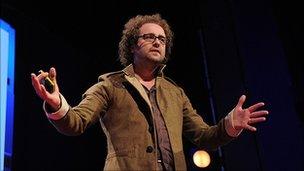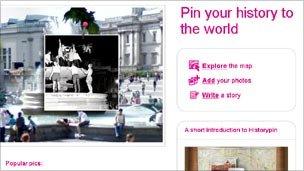Taking a journey back in time
- Published

Chris Wild reckons his website is his Time Machine
Forget Dr Who; Chris Wild is a real Time Lord.
The 40-year-old ex-museum curator and entrepreneur describes himself as a retronaut - someone who goes back in time "using just his perception".
He is building a website - known as the Retroscope - made up of millions of pieces of content including videos, pictures, music and text from public and private archives.
"The website is a portal into time and space," he told BBC News at the TED Global (Technology Entertainment and Design) conference in Oxford.
"I have always wanted to go back in time and I was constrained by the practical difficulties of doing that.
His "time machine" is, at its simplest level, a website powered by a massive database.
Users can search for objects, places or people and use that as their entry point into history, he said.
Results can be displayed in various ways, such as on a map or as a collage of pictures and videos.
These collages are arranged in concentric rings with more relevant results at the centre. A time line stretches into the screen allowing people to go back in time, like flicking through pages in a Rolodex.
"It is hard to describe without seeing it," said Mr Wild.
The mass of connected data allows people to choose their own "entry point" into history.
"I was talking to someone about Captain Beefheart and that was his entry point," he said.
That search could bring up music, videos or pictures that linked to geographical locations associated with the singer.
Similarly, searching for the Dakota Building in New York, brings up a series of juxtaposed historical photographs that stretch back to 1890, just a few years after it was built.
Retronaut news
In theory, users can use that single point as a leaping off point to explore the whole database - spanning the globe and several hundred years of information and objects.
Crucially, people can also upload their own content to the site.
"As well as exploring this information you are adding your own personal story to it and your own chronology and your own material."
Retronauts, as users are known, can comment on any new content and can also connect items together if they see a relationship between two items.
This builds up links in the database and creates new historical narratives.
The site also incorporates elements of social networks.
"Users can tag themselves in pictures and share information with each other, with similar functions to Facebook and Twitter," he said.
Each retronaut has a news feed on their own page which shows their friend's content and any new content that is related to items they have uploaded or have an interest in.
"That allows you to say 'Hey! I just found this in Paris in 1879 - isn't this cool'," said Mr Wild.
The Retroscope is just one of a rash of new projects hoping to bring the dimension of time to the web.
Google, for example, now offers History Pin, a site that allows anyone to upload historic images to its Street View software.
History playground

Similarly, the Museum of London has developed an augmented reality application for smartphones that overlays the capital's street's with old pictures.
"Time has been neglected until now," said Mr Wild.
"In part, that is because it is extremely difficult to visualise," he told BBC News.
The site is not yet live, but Mr Wild hopes that it will soon be a free service, open to all.
In addition, he is currently working with some of the country's largest archives - at museums, libraries and companies - in an attempt to open them to the masses.
One, he said, has 4km of shelves with material that they would like to visualise, link and share.
"The main thing that I wanted to do was change history into a playground," he said.
The 2010 TED Global conference runs from 13 to 16 July in Oxford, UK.